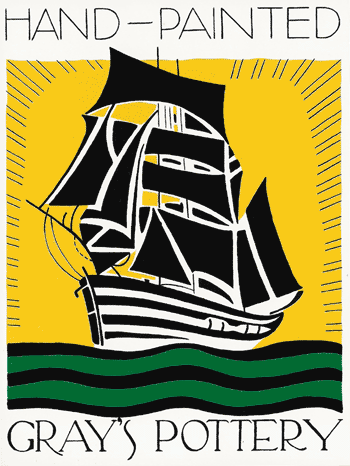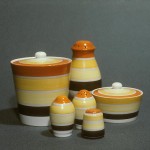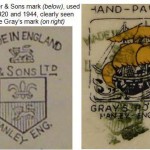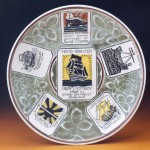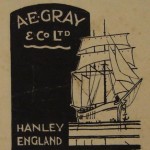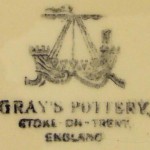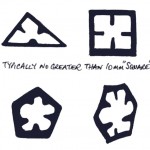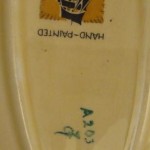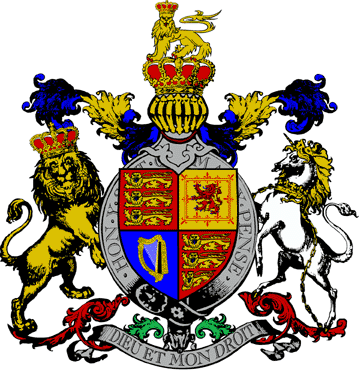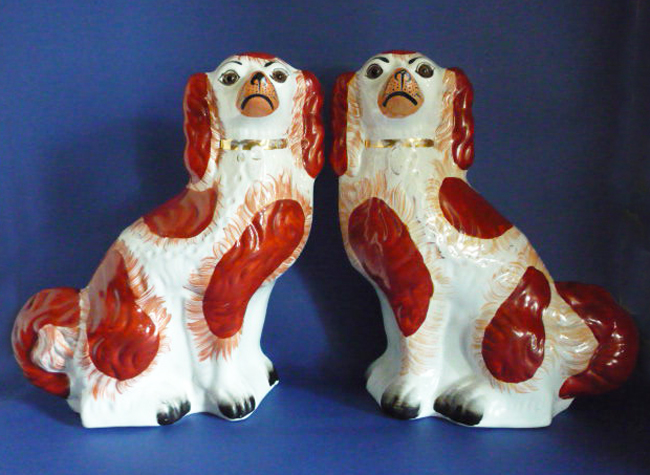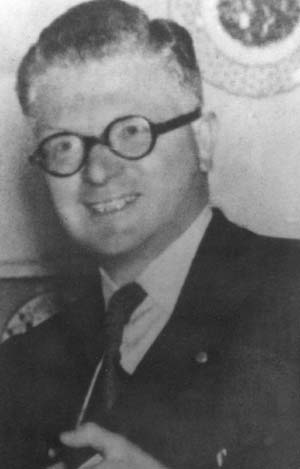- Illustration 7: The impressed Bishop & Stonier date mark, 2 above 29. Technical note: The contrast on this image was adjusted to best show the date mark.
- Illustration 8: Examples of kitchenware in Harmony, pattern 8312, introduced in 1929. The items in the picture have various Clipper backstamps, from N1 to N9.
- Illustration 3: Example of dual marks – the Lancaster mark can clearly be seen beneath the Gray’s mark.
- Illustration 2: Jack Bond’s alternative backstamp design, produced in 1931. This was rejected in favour of the Clipper backstamp.
- Illustration 4: The stamped version of the Pharaoh’s Boat backstamp.
- Illustration 5: Johnson’s Rosedawn mark can be seen here in an example of Gray’s pattern A7083.
- Illustration 6: A Wood’s dish showing the impressed mark W931.
Pictured top: The N Clipper backstamp used on all wares between 1931 and 1961 with minor variations.
Gray’s Pottery used many backstamps throughout the life of the company. 53 of them are included on this website but only 20 represent significantly different versions. However, of these, just six form major families of marks (ILLUSTRATION 1), five of which are based on ship designs; the 1st and 2nd Galleons, the Liner, the Clipper and the Pharaoh’s Boat. The exception is the ‘Sunburst’ Gloria Lustre mark. Little documentation exists about precisely when particular stamps were in use but a letter written to AE Gray’s son Robin in 1977 from one of his relations, Major General GA (Jack) Bond, contains the following:
“As I remember it, I offered AEG the choice of two backstamps by means of black & white sketches (the other one recently turned up and is enclosed herein (Illustration2) ), in 1932. I thought the mixture of steamships, sailing boats, sunbursts, and other things he was using were low grade and old fashioned. At the same time I sent another for use on silver lustre alone – the mediaeval ship something like this (sketch added). I don’t remember when the accepted stamps were taken into use, but it was at Hanley. Sorry not to be more certain, but cannot feel that the history of England is much to be affected by a slight uncertainty in this matter!”
From this we know that Jack Bond, an accomplished artist who had produced a number of designs for the pottery, created both the Clipper and the Pharaoh’s Boat backstamps, though his memory regarding the date of their introduction may have been slightly erroneous. His Clipper mark was highly successful and was in use, subtly modified as appropriate, from the early 1930s until the last of Gray’s Pottery products were made in 1961.
DUAL MARKS
Because Gray’s Pottery was a decorating business – buying undecorated ‘white ware’ from other pottery manufacturers – the pieces that the company bought usually already had a backstamp. Many Gray’s pieces therefore often have two backstamps (ILLUSTRATION 3) : the original maker’s mark and the Gray’s mark on top of it, usually large enough and bold enough to obscure the mark beneath. Mr Gray would not necessarily want the white ware producer to take any credit for the pottery, hence his use of bold backstamps.
A rare exception to the common sight of dual marks can be found in the use of one version of the Pharoah’s Boat (ILLUSTRATION 4) backstamp. Produced by some sort of rubber stamp, this mark was applied to ware exclusively made for Gray’s Pottery. Typically, it can be found on matt-glazed ware supplied by Kirklands of Etruria or Whieldon Ware from Winkle & Co/Ridgways of Shelton.
Dual marks are often an aid in dating items. The earthenware producer Johnson Brothers of Hanley, Stoke-on-Trent, was a major supplier to Gray’s Pottery and its products often have distinct date-related marks such as ‘Pareek’ (registered in 1925), ‘Greydawn’ (introduced in 1928) or ‘Rosedawn’ (introduced in 1930) (ILLUSTRATION 5). Lancaster & Sons, later Lancaster & Sandland, used distinctive marks such as ‘English Ware’ from 1944 or ‘Sandland Ware’ from 1949.
The presence of an impressed mark can also be useful. The most common is ‘JOHNSONS’, usually on cup bases, but early Gray’s ware often has impressed numbers. Examples are W931 (ILLUSTRATION 6), indicating a piece by Wood & Sons of Burslem, Stoke-on-Trent, and made in September 1931. Bishop & Stonier of Hanley, Stoke-on-Trent, supplied Gray’s with white ware during the first 20 years of the company’s existence. The characteristic entwined snake mark from Bishop & Stonier is often accompanied by one number on top of another: 2/29 meaning February 1929 (ILLUSTRATION 7).
DATING OF WARE
The backstamps illustrated on this site have been taken from actual items of Gray’s Pottery and the dates shown have been deduced from a wide range of evidence. Note that the information is given in good faith, based on pieces of pottery, oral evidence from Gray’s Pottery employees and documentary material in contemporary sources. Very little original company material has survived, meaning that potentially useful primary source data no longer exist. Researchers and collectors must be aware that attributing dates is not an exact science and there are many exceptions to whatever rules exist!
Collectors must also be aware that Gray’s operated a ‘matchings’ service for a considerable time: customers could continue to purchase particular patterns long after they had been deleted from the current range. It is therefore possible to find, say, an example of a 1930s design with a 1950s backstamp because it was produced in later years as a ‘matching’. Popular patterns, kept in production for many years, will have a variety of marks: pattern 8312, named Harmony (ILLUSTRATION 8), and probably designed by Susie Cooper in 1929, continued in production for almost 30 years and can be found with the 2nd Galleon, Liner, Clipper and Pharaoh’s Boat marks.
HAND-PAINTED
The absence of the words ‘HAND-PAINTED’ (eg compare N2 and N3, H1 and H2) may simply have been a practical consideration where there was little space to put the complete mark. However, the absence of these words on mark N5 (ie mark N6) does seem to coincide with the trend for less or even no hand-painting on the pottery in the 1950s.
THE MYSTICAL REBUS!
Special Gloria Lustre patterns in the 5000 and 6000 series and at the start of the 7000 series of patterns, often carry a strange hand-painted rebus. It may be three, four, five or six-sided. Its significance is still not known (ILLUSTRATION 9).
RETAILERS
Gray’s Pottery supplied many top quality retailers almost from the start of the company’s existence. It is therefore possible to find pieces with such names as Harrods, Mappin & Webb and William Whiteley (London), Awmacks (Leeds), Grace Bros (Sydney), Mottahedeh (New York). Some of these names appear alongside the Gray’s backstamp, others replace it, such as with Heals of London. Retailers section
STOKE-ON-TRENT
Because of the various town references included in many Gray’s backstamps, it is worth mentioning here that today’s conurbation of the City of Stoke-on-Trent was formed in 1910 following the federation of the six towns of Tunstall, Burslem, Hanley, Stoke-upon-Trent, Fenton and Longton.
Credit:
Paul & Kathy Niblett

